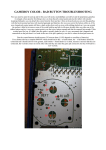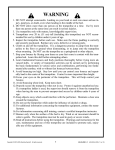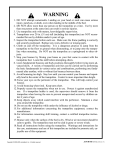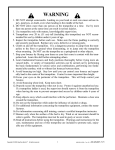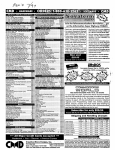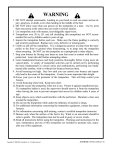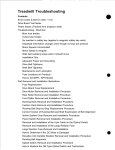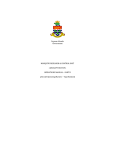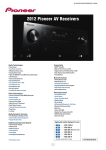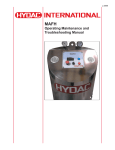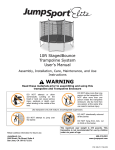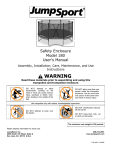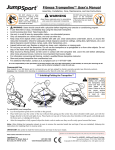Download Safety Enclosure User`s Manual, Models 280, 380, & 480
Transcript
Safety Enclosure Models 280, 380, and 480 Fits round trampolines 10-14 feet U.S. Patents #6053845, 6261207, and Patents Pending Assembly, Installation, Care, Maintenance, and Use Instructions WARNING Do not attempt or allow somersaults on the trampoline. Landing on your head or neck can cause serious injury, paralysis or death, even when landing in the middle of the bed. Do not allow more than one person on the trampoline (inside the trampoline enclosure) at a time. Use by more than one person at the same time increases the chance of injury. Do not attempt to jump over the barrier (netting). Do not hang from, kick, cut or climb on the barrier (netting). Use trampoline and trampoline enclosure only with mature, knowledgeable supervision. Read these materials prior to assembling and using the Trampoline and Trampoline Enclosure. User Weight Limit: Model 280: 200Lbs, Model 380: 230Lbs, Model 480: 295Lbs Copyright © 1997-2005 JumpSport, Inc. All rights reserved. 1 JCSE M280, 380, 480 (SE-INS-J-0248-7 rev 11) ATTENTION It is the responsibility of the purchaser to become familiar with all of the information in this booklet, to convey the warnings to all users, and to enforce the manufacturers rules for safe use. This unit is not intended for commercial or public use; and is therefore, strictly prohibited. Trampolines, being rebounding devices, propel the performer to unaccustomed heights and into a variety of body movements. Therefore, it is emphasized that all purchasers, and all persons using the trampoline, become familiar with the rules for safe use. Misuse and abuse of this trampoline is dangerous, and can cause serious injuries. The purchaser/user of this piece of equipment is assuming a degree of risk for which the manufacturer cannot be responsible. Read this information thoroughly before allowing the trampoline to be used. Keep this manual available for your review, and for review by all potential users. If there are questions please telephone the manufacturer for further explanation. The phone number is 1-408-213-2551, hours are 8:00am – 5:00pm Monday through Friday, Pacific Time. JumpSport, Inc. P.O. Box 2446 Saratoga, CA 95070 1-408-213-2551 Copyright © 1997-2005 JumpSport, Inc. All rights reserved. 2 JCSE M280, 380, 480 (SE-INS-J-0248-7 rev 11) Table of Contents Cool JumpSport Accessories…..………………………………………………………………….….4 Assembly: Placement of product…………………………………………………………………………………..5 Safety Enclosure Parts List………...…………………………………………………………………6 Assembly Instructions (Safety Enclosure)……………………………………………………….7-14 Care & Maintenance: Care and Maintenance…………………………………………………………………………….....15 Care and Maintenance Check List………………………………………………………………….16 User Instructions: Precautions……………………………………………………………………….……………………17 Warnings……………………………………………………………………….………………………18 Basic Trampoline Skills Bouncing……………………………………………………………………………………….19 Arm Action……………………………………………………………………………………..19 Bounce Variations…………………………………………………………………………….19 Basic Landing Positions Seat Drop……………………………………………………………………………………...20 Hands and Knees Drop………………………………………………………………………20 Front Drop……………………………………………………………………………………..20 Beginning Twisting…………………………………………………………………………....21 Seat Drop, Half Twist, Seat Drop (Swivel Hips)…………………………………………...21 Front Drop, Half Twist, Front Drop (Turn Table)……………………………………...…...21 Seat Drop, Full Twist to Seat Drop (Barrel Roll)……………………………………..…....22 Additional Twisting………………………………………………………………………..…..22 Warranty Information………………………………………………………………………..Last Page Copyright © 1997-2005 JumpSport, Inc. All rights reserved. 3 JCSE M280, 380, 480 (SE-INS-J-0248-7 rev 11) Have friends over for a backyard camp out! Let’s face it - the ground is the hardest place on earth particularly when you have been sleeping on it all night. Now you can rough-it in style with the JumpSport® BigTop Tent™ (we won’t tell Mom that you are better rested for those Saturday morning chores). ♦ Four windows with mosquito netting ♦ Sewn-in floor to keep the elements out ♦ Plenty of room for games and friends ♦ Installation in seconds! Don’t miss out on these fun accessories and more at www.jumpsport.com ! JumpSport Basketball Sets More fun than a tuna sandwich! Jump higher than tall buildings! Jam like the pros (just don’t hang like them)... Whether you are into practicing your outside shot or improving your up-close game, the JumpSport® basketball goal is a fun way to avoid homework. Heck, athletic scholarships pay for college too. Copyright © 1997-2005 JumpSport, Inc. All rights reserved. 4 ♦ Our most popular accessory ♦ Easily installed to your safety enclosure ♦ Set includes basketball JCSE M280, 380, 480 (SE-INS-J-0248-7 rev 11) ASSEMBLY INSTRUCTIONS Read through all assembly steps carefully before beginning the assembly process. Refer to drawings for clarification. Pre-Assembly: Pick an appropriate spot for your trampoline. Trampoline Placement ⇒ Adequate overhead clearance is essential. A minimum of 24 feet (7.3 meters) is recommended from ground level. Provide clearance for wires, tree limbs, and other possible hazards. ⇒ Lateral clearance is essential. Place the trampoline and trampoline enclosure away from walls, structures, fences, pools, and other play areas. Maintain a clear space on all sides of the trampoline. ⇒ Place the trampoline and trampoline enclosure on a level surface before use. ⇒ Use the trampoline and trampoline enclosure in a well-lighted area. Artificial illumination may be required for indoor or shady areas. ⇒ Secure the trampoline and trampoline enclosure against unauthorized and unsupervised use. ⇒ Remove any obstructions from beneath the trampoline and trampoline enclosure. ⇒ The trampoline enclosure is only to be used as an enclosure for a trampoline and the trampoline must be of the appropriate size as covered by the specific enclosure. ⇒ The owner and supervisors of the trampoline are responsible to make all users aware of practices specified in the User Instructions section of this manual. Copyright © 1997-2005 JumpSport, Inc. All rights reserved. 5 JCSE M280, 380, 480 (SE-INS-J-0248-7 rev 11) Assembly will require: -7/16” deep socket and rachet, or adjustable wrench -1/2” deep socket and rachet, or adjustable wrench -Tape Measure -8 foot A-Frame Ladder may be useful for some steps (use care and follow procedures for use) Ref. # Part # H1 SE-EYE-X-0026RJ H2 SE-CAP-X-0388 H3 SE-NUT-X-0391 H4 SE-UBO-J-0068 H5 SE-NUT-X-0035 H6 SE-CLA-X-0025 H7 SE-CAP-X-0368 H8 SE-NUT-X-0462 A SE-POL-J-0243R1 A2 SE-POL-KJ-0288R2 B SE-FOA-X-0027 C SE-FOA-X-0028 D SE-SLE-J-0746 E SE-CAP-X-0019 G SE-NET-J-0031 (SE-NET-J-0032) H SE-BUC-X-0012 I SE-BUN-X-0016 J SE-STR-X-0048 K SE-BUN-X-0015 L SE-WRN-J-0076 M SE-CAB-X-0017 Description Quantity Eyebolt 8 8 8 24 48 24 16 8 8 8 8 8 8 8 1 Eyebolt Cap Hex nut with nylon insert U-bolt Hex nut with nylon insert Pole Clamp Ball Nut Steel Acorn Nut Upper support pole Lower support pole Short Support Pole Cushion Long Support Pole Cushion Foam Sleeve Ball End Cap Safety Net Assembly HARDWARE (Model 480 Net) Plastic Slide Buckle (1 inch) 1 1 16 8 1 1 Bungee "T" Anchor Pad Strap (2 feet) Bungee Cord, Short Safety Placard Cable Tie Models 380 & 480 Only N P Q SE-BUN-X-0014 SE-STR-X-0049 SE-CAP-X-0593 Bungee Cord, Long 8 8 8 Pole Strap (with loop) U-bolt Cap Cover Approximately 2 feet Approximately 1.5 feet Approximately 7 feet Approximately 13 feet PARTS NOT TO SCALE Copyright © 1997-2005 JumpSport, Inc. All rights reserved. 6 JCSE M280, 380, 480 (SE-INS-J-0248-7 rev 11) STEP 1: Assemble support poles Step 1 Create one support pole assembly by inserting small end of lower support pole (A2) into large end of one upper support pole (A) and snap button into hole. Upper Pole Lower Pole STEP 2: Install foam and foam sleeves Slide a long pole cushion (C) onto upper support pole, followed by a short pole cushion (B). Slide foam sleeve (D) over both foam pieces starting at the top of pole. STEP 3: Install ball end cap Step 2 Install ball end cap (E) over top of pole. Rotate so that the holes are aligned. Push eyebolt (H1) though the eyebolt cap (H2), then insert assembly into the small hole on the ball end cap (E). Hand tighten hex nut with nylon insert (H3) onto end. When in place, the opening on the eyebolt should face upward toward the top of the pole. The eyebolt assembly should be loose enough for the upper strap of the safety net to be hung on the eyebolt hook (see Step 6). Slip foam sleeve and foam up into skirt of ball end cap. Repeat Steps 1-3 for each support pole assembly to be attached to the legs of the trampoline. IMPORTANT: One pole has a warning label at the bottom of the pole. The label should be visible when the eyebolt hook faces outward. Step 3 IMPORTANT: These installation instructions are oriented for trampolines with 4 sets of U-legs. Please visit the “Assembly Tips” section at www.jumpsport.com for trampolines with other types of leg configurations. H8 Copyright © 1997-2005 JumpSport, Inc. All rights reserved. 7 JCSE M280, 380, 480 (SE-INS-J-0248-7 rev 11) STEP 4: Upper U-bolt assembly ♦ Attach U-Bolt to each leg (at frame). Slide two U-bolts (H4) onto the frame on either side of the trampoline leg. Rotate the bolts Step 4 Eyebolt hook (H1) must face out away from the center of the trampoline H1 so the ends face outward, away from the center of the trampoline. ♦ ♦ Insert a pole clamp (H6) onto upper ends of the two U-bolts. Thread hex nut with nylon insert (H5) onto U-bolt ends - hand tighten only. Repeat with a clamp on the lower ends of the two U-bolts. Slide support pole down through the U-Bolt Assembly. Rotate the support pole so the eyebolt hook (H1) faces directly out, away from the trampoline. Hook to Rail Must be 72” CAUTION : FAILURE TO DO SO CREATES A HAZARD THAT COULD RESULT IN SERIOUS INJURY ♦ Using a measuring tape, make sure the distance from the eyebolt hook to the top of the trampoline rail is 72 inches. IMPORTANT: HOOKS MUST BE 72 INCHES FROM THE Top rail of trampoline frame TOP RAIL OF THE TRAMPOLINE FOR THE NET TO BE HUNG CORRECTLY. Support pole ♦ Fold skirt of trampoline pad back so that it will NOT be pinched between the pole and trampoline frame. ♦ Tighten the U-bolt assemblies evenly with crescent or socket wrench. When the gap between the pole and the clamp disappears, stop tightening nuts. NOTE: AT LEAST ONE POLE WILL HAVE A PROMINENT WARNING LABEL ATTACHED TO IT. INSTALL THIS POLE WHERE YOU WANT THE DOOR. THIS LOCATION SHOULD BE NEAR THE WARNING LABEL /SAFETY INSTRUCTIONS PROVIDED WITH YOUR TRAMPOLINE. LABEL ON POLE MUST BE VISIBLE WITH EYEBOLT FACING OUTWARD. ♦ T r a m p o l i n e L e g Install U-Bolt Cover (Q) over upper U-bolt assembly and secure using cable (zip) tie (see figure B). Step 5 STEP 5: Lower U-bolt assembly ♦ Attach U-bolt at bottom of support pole. Intall lower U-bolt assemblies approximately 2-3” from the end of the support pole so that the ends face inward, toward the center of the trampoline. Screw protective, ball nuts (H7) on to each leg of U-bolt. NOTE: TRAMPOLINE LEGS VARY IN SIZE - IF AFTER Q DOING THIS PROCEDURE THE BALL NUT IS NOT TIGHT AGAINST THE NYLOCK NUT, REMOVE BALL NUT AND USE HACKSAW TO CUT OFF END OF UBOLT WITHIN 5-6 THREADS OF NYLOCK NUT. SAND OR FILE ANY SHARP EDGES, AND REINSTALL BALL NUT. ♦ Figure B Repeat Step 4 and Step 5, connecting each support pole around the trampoline. Copyright © 1997-2005 JumpSport, Inc. All rights reserved. 8 JCSE M280, 380, 480 (SE-INS-J-0248-7 rev 11) STEP 6: Preparing the net Find an area (approximately 50 ft) to straighten out the net. With one person at each end, pull and shake net so that the meshes are evenly distributed along straps. ♦ One end of the support strap has loops, as this will be the end that is hung first. The WIDER support strap will be the top of the net. Step 5 Measure the net: The net should measure 46 feet from edge to edge of net (see illustration). If the net measures less than 46 feet, untie the knots in the support straps at the end of the strap without loops. Stretch net to 46 feet, and re-tie the support straps so that the net will NOT slide along the support straps. NOTE: IF YOU OWN A TRAMPOLINE WITH A DIAMETER LESS THAN 14 FEET, ASSEMBLY WILL BE DIFFERENT FOR THE NET (STEPS 68). VISIT “ASSEMBLY TIPS” AREA ON OUR WEB SITE WWW.JUMPSPORT.COM AND LOOK FOR A FILE TITLED “TRAMPOLINES SMALLER THAN 14 FT IN DIAMETER.“ INSTRUCTIONS MAY BE VIEWED, PRINTED OR FAXED TO YOU AUTOMATICALLY. Top Edge with Wider Support strap ♦ Step 6 End with loops 46 feet The four corners of the net are fixed with knots. (If necessary) Untie knots at this end, stretch net to 46ft, and re-tie to the sewn strap at the end of the net. Locate the pole near the safety instructions / warnings on the trampoline: ♦ Lay the end of the net with the loops down on the bed of the trampoline next to this pole. ♦ Continue laying the net down (clockwise) around the edge of the trampoline bed. End of net with loops NOTE : A LTHOUGH PLACED ON THE TRAMPOLINE FOR SET UP, NET WILL BE INSTALLED ON THE OUTSIDE THE POLES (SEE NEXT PAGE). Sewn strap on net Important: Although placed on the trampoline for set up, net will be installed on the outside the poles. (see next page) Warning label on trampoline bed Copyright © 1997-2005 JumpSport, Inc. All rights reserved. 9 JCSE M280, 380, 480 (SE-INS-J-0248-7 rev 11) STEP 7: Attach the net to poles Figure 1 Orientation for installation of net Poles are numbered according to Figure 1 in order to clarify orientation for assembly. NOTE: NET IS HUNG ON OUTSIDE OF POLES. Hang end of net with loops to pole #1 Slip loop of WIDE strap over pole #1 ball cap and into eyebolt. Hang net on OUTSIDE of pole 2 Pull the netting to pole #2. Lift the entire net assembly over the pole so the net is on the outside of the pole. With tension on the net, hook the strap and a mesh of net into eyebolt hook, so it will maintain its position. Continue to hang net on OUTSIDE of remaining poles Repeat, hanging the net on the OUTSIDE of the remaining poles including pole #1. Slip loop over pole 1 ball end cap and into eyebolt Pole 1 Step 7 The net must be pulled tight at each pole and then hung. It will not reach the bed of the trampoline in many areas during the hanging process, if hung correctly. Net should be hung on OUTSIDE of all poles After hanging the net on the outside of pole #1, pull the end of the net toward pole #2. Stretch the strap to pole #2, and form a loop by installing slide buckle (H). Slip loop over ball end cap of pole #2, so it rests in hook of eyebolt. Net overlaps to create doorway Finishing end of net will be anchored to pole #2 Copyright © 1997-2005 JumpSport, Inc. All rights reserved. 10 JCSE M280, 380, 480 (SE-INS-J-0248-7 rev 11) STEP 8: Form the doorway by creating overlap Pole 2 Step 8 Pole 1 When hung correctly, inner and outer panel of net should overlap by 1 to 3 feet (minimum 6 inches in middle, due to “hour glass shape.”) IMPORTANT: IF THE NET DOES NOT OVERLAP BY AT LEAST 6 INCHES IN THE MIDWAY UP THE NET, READJUST OR CALL CUSTOMER SUPPORT FOR HELP. Secure lower ends of net ♦ Attach the Bungee “T” Anchor (I) around the loop in the lower support strap. ♦ Pull the bungee “T” anchor toward pole #1 until the starting edge of the net is nearly vertical. ♦ Feed the “T” through the “V” ring closest to pole #1. The “T” anchor will be installed to the inside of the trampoline pad. ♦ Pull the other end of the lower support strap (attached to the outside section of net) toward pole #2, wrap around rail of trampoline two times, and tie securely to upper U-bolt. Outer panel Loop on bottom strap is connected to V-ring on trampoline mat, using a Bungee “T” Anchor on the inside of the trampoline pad. Lower support strap on finishing end secured to upper U-bolt on pole 2 Bungee “T” Anchor (I) Copyright © 1997-2005 JumpSport, Inc. All rights reserved. 11 JCSE M280, 380, 480 (SE-INS-J-0248-7 rev 11) STEP 9: Secure lower support strap at each pole with short bungee cord Work the net down each pole. From the outside of the trampoline, hook net and lower support strap around the lower edge of each pole cushion. Safety Pad At each pole, wrap a short bungee cord (K) around the lower support strap. Wrap the ends of the bungee cord around leg of trampoline and hook loops securely over lower U-bolt clamp. Repeat at the remaining poles. Short Bungee Cord (K) Lower support strap Step 9 Ends of short bungee cord wrap around leg of trampoline and hook over lower Ubolt clamp View of lower clamp as if looking out from under trampoline STEP 10: Tighten eyebolt assemblies and install acorn nuts Step 10 Make sure that the upper strap and one mesh net are seated into the eyebolt hook, and that the eyebolt hook is facing upward. Tighten hex nut with nylon insert (H3) using socket or crescent wrench so that the eyebolt cap closes the hook of the eyebolt, locking the net into place. Install steel acorn nut (H8) onto the end of eyebolt. Do not overtighten acorn nut. H3 H8 Repeat at the remaining poles so that the net is locked into place. Copyright © 1997-2005 JumpSport, Inc. All rights reserved. 12 JCSE M280, 380, 480 (SE-INS-J-0248-7 rev 11) STEP 11: Connect lower support strap to bed of trampoline using pad straps In every “panel” of the net between two poles - except at the overlapping entry approximate the two points on the lower support strap that would divide the panel into thirds. At one of these points, wrap a Pad Strap (J) through the lower support strap, and pull it so that you have two equal lengths. NOTE: PAD STRAP MUST WRAP THOUGH THE LOWER SUPPORT STRAP ONLY. DO NOT WRAP THROUGH NET. Feed one end of the pad strap through a “V” ring on the bed of the trampoline directly below the point where you have wrapped the strap. From underneath the trampoline, pull the strap tight enough so that the lower support strap is approximately 2 inches from the “V” ring, then tie the ends of the pad strap together. Repeat with a second strap at the other “point” in the panel. Upon completion, you will have secured the panel in two locations to the bed of the trampoline. Repeat in the 6 remaining panels (excluding the panel with the overlapping net). View from center of the trampoline looking towards the net Step 11 P o l e 1/3 1/3 Pad 1/3 P o l e Pad Mat In all panels (except the entry) secure the net to the bed of the trampoline in two locations, using pad straps. NOTE: THE NET IS PULLED OVER THE TOP OF THE TRAMPOLINE PAD AND CONNECTED TO THE TRAMPOLINE MAT BETWEEN EACH SET OF POLES. DO NOT PULL NETTING AROUND THE OUTSIDE OF THE TRAMPOLINE FRAME IN THE AREAS BETWEEN THE POLES. Tie each pad strap securely to a V ring on bed of trampoline (Trampoline pad not shown for clarity) Mat J View from INSIDE of trampoline. Trampoline pad not shown to clarify connections. View of net from OUTSIDE of trampoline Net is pulled in toward the trampoline mat, over the top of the pad. Copyright © 1997-2005 JumpSport, Inc. All rights reserved. 13 JCSE M280, 380, 480 (SE-INS-J-0248-7 rev 11) Step 12 STEP 12: Connect lower support strap to bed of trampoline at overlapping panels In the panel with the overlapping net, wrap a pad strap through the lower support strap midway between the end of the inside panel and pole 2, and tie to V ring (as outlined above). Repeat this process with a pad strap around the lower support strap midway between the end of the of the outside panel, and the pole 1. STEP 13: Hang warning placard from net near entrance Attach warning placard (L) to the outside of the net where it will be visible from the entrance, using cable tie (M). In the panel with overlapping net, wrap a pad strap around the middle of the inner panel. Repeat for outside panel. Note: The upper and lower support straps may need periodic tightening. Check buckles and straps regularly. If the net sags due to extended use, we recommend repeating steps 7 through 11 (7 through 14 if model 380 or 480 – see next page), so that net is tight again. Copyright © 1997-2005 JumpSport, Inc. All rights reserved. 14 JCSE M280, 380, 480 (SE-INS-J-0248-7 rev 11) Models 380 and 480 only STEP 14: Attach long bungee cord to pole Attach one of the long bungee cords (N) to each pole directly below the foam. This can be done by wrapping a bungee cord around the pole (below the pole cushion), and threading one end through the other. Pull all of the slack through the loop, so that the anchored end “chokes” the pole. Weave bungee cord vertically through every 3rd mesh of net, and install loop over ball end cap N Connect long bungee cord to pole by feeding one end through the other Attach net to bungee cord Locate the column of netting closest to the pole, and weave free end of bungee cord vertically up (in and out) through every 3rd square (approximately). Repeat at each of the remaining poles NOTE: A LADDER MAY BE NECESSARY FOR THIS STEP. PLEASE USE CAUTION, AND COMPLY WITH THE WARNINGS ON YOUR LADDER. AT THE TOP, LOOP THE BUNGEE CORD OVER BALL END CAP . View from outside of trampoline STEP 15: Complete suspension system Attach bungee cords to poles, using pole straps From the inside of the trampoline, hook the looped end of pole strap (P) over each ball cap. Weave pole strap through every second inside loop of bungee cord. Do NOT weave pole strap through net at any point. Wind the strap around the pole, weaving it through every other inside section of bungee cord (N) as you wrap. This will create approximately 4-6 wraps. Tie the end of the strap to the upper U-bolt. Repeat at the remaining poles with bungee cords. IMPORTANT: DO NOT WEAVE THE POLE STRAP THROUGH THE NET. THE POLE STRAP MUST WRAP THROUGH THE BUNGEE CORD ONLY. IF THE POLE STRAP IS WRAPPED THROUGH THE NET, THE SYSTEM WILL NOT WORK PROPERLY. Copyright © 1997-2005 JumpSport, Inc. All rights reserved. 15 JCSE M280, 380, 480 (SE-INS-J-0248-7 rev 11) Pole 1 Pole 2 To enter the JumpCourt Safety Enclosure, step up on the frame between pole 1 and 2. Move right, slipping between the inside and outside panel of net. View from inside of the trampoline safety enclosure Enjoy your JumpCourt Safety Enclosure! For more information about the JumpCourt® AirJam™ or ProFlex™ Basketball Sets, JumpCourt GamePak™, JumpCourt BigTop Tent™, and other fine products, visit our website at www.jumpsport.com Copyright © 1997-2005 JumpSport, Inc. All rights reserved. 16 JCSE M280, 380, 480 (SE-INS-J-0248-7 rev 11) CARE & MAINTENANCE CARE The trampoline enclosure is intended to be used by one person at a time, weighing up to [200lbs, Model 280] [230lbs, Model 380] [295lbs, Model 480.] This unit is designed for year-round outdoor use. However, in climates of cold weather where snow and ice is prevalent, we recommend the net be taken off and stored in a dry area if not in use. MAINTENANCE Your trampoline enclosure is manufactured using quality materials and is finely-crafted to provide you and your family with many years of enjoyment and exercise. Proper maintenance and care will help to prolong the life of the enclosure and reduce the possibility of injury. The following guidelines should always be observed: Inspect the unit before each use and replace any worn, defective or missing parts. The following conditions present potential hazards and increase the danger of personal injury. IF ANY OF THESE CONDITIONS EXIST, THE DEVICE SHOULD BE DISASSEMBLED OR OTHERWISE PROTECTED AGAINST USE UNTIL THE CONDITION IS REMEDIED. A. Missing, improperly positioned, or insecurely attached barrier (netting) or enclosure support system (frame) padding and pole caps B. Punctures, frays, tears, or holes worn in the barrier (netting) or support system (frame) padding C. Deterioration in the stitching or fabric of the barrier (netting) or support system (frame) padding C. Ruptured or over-stretched springs E. A bent or broken support system (frame) F. Sagging barrier (netting) G. Sharp protrusions on the support (frame) or suspension system SPECIAL CONSIDERATIONS WIND It is possible for the trampoline to be blown about by a high wind. If you anticipate high winds, the trampoline should be moved to a sheltered location, disassembled, or the top of the frame should be secured to the ground with the use of a trampoline anchor kit. The anchor kit can be found at www.jumpsport.com Use a JumpSport® trampoline anchor kit to tie down the trampoline. Make sure the ends of the stakes are protected and the ropes are visible to users. MOVING THE DEVICE If you need to move your trampoline periodically, it should be moved by at least three people, kept horizontal and lifted slightly to move. Disassemble the unit for any other type movement. Copyright © 1997-2005 JumpSport, Inc. All rights reserved. 17 JCSE M280, 380, 480 (SE-INS-J-0248-7 rev 11) CARE & MAINTENANCE SAFETY CHECK LIST IMPORTANT: Inspect the device before using and replace any worn, defective, or missing parts. Pole Cushions: Pole and pole pad life expectancy is one to two years. Do not allow jumpers to grab pad in order to themselves onto trampoline. pull Safety Check Safe Unsafe Check for: NET: Vinyl Deterioration Replace ______ ______ Foam Deterioration Replace ______ ______ Missing Pads Replace ______ ______ The net, strapping and bungee cords will require frequent inspection for deterioration or fraying. If these are visible, discontinue use until the part is replaced. Check for: Faded & breaking top/bottom strap Replace straps ______ ______ Brittle & tearing net Replace ______ ______ Cuts, tears, or holes in net /strapping Replace ______ ______ Missing Warning Placard Phone manufacturer for replacement ______ ______ Rust Clean & paint ______ ______ Structural failure Replace ______ ______ Bent frame Repair or replace part ______ ______ Sharp protrusions Repair ______ ______ Missing frame warning labels Phone manufacturer for replacement ______ ______ STEEL TUBING: Check for: SAFETY RULES – Review this manual with all jumpers. Maintain all warning labels and signs. If labels or signs become lost or unreadable write or telephone the manufacturer for free replacements. Copyright © 1997-2005 JumpSport, Inc. All rights reserved. 18 JCSE M280, 380, 480 (SE-INS-J-0248-7 rev 11) USE OF YOUR PRODUCT PRECAUTIONS The majority of users of trampolines are children, and therefore need close supervision and rules to follow while playing on the device. These rules must be enforced by whomever is responsible for the care of the children. It is strongly recommended that the buyer of this product go over the rules and recommendations in the packet of information supplied, including those in this manual. It is also strongly recommended that these rules and recommendations be supplemented with those of your own: (e.g., the time that jumping is allowed, when neighbors can visit, etc.), and that these rules and recommendations be reviewed with anyone who is going to jump on the trampoline. If it is possible, these rules should be reviewed with the parents or guardians of any visitors who may be jumping on the trampoline. Before you Jump, Read this: Please read the warnings on the next page with the following in mind: ⇒ The trampoline enclosure is not designed to prevent injuries associated with unsafe use of the trampoline, or associated with more advanced skills like flips, somersaults, or acrobatic maneuvers.Do not attempt any of these activities. ⇒ Each user should become familiar with the wanings, precautionary statements and usage instructions before jumping. ⇒ The trampoline enclosure does not replace the need for supervision by a responsible, knowledgeable adult. ⇒ Allow only one user to use the entrance at one time. ⇒ When exiting do not jump off the edge of the trampoline. Always sit on the edge, then carefully lower your body onto the ground. ⇒ Do not attach other apparatus to the trampoline enclosure unless it is a JumpSport-approved device. Any additional JumpSport Accessory that you may attach to the trampoline enclosure must be attached and used only in accordance with the instructions for such accessory. It is essential that trampoline users follow a carefully planned safety program so that the trampoline can be fully enjoyed. Most accidents can be classified into the following headings: LANDING ON SPRINGS OR FRAME The risk of falling on, landing between the springs, or hitting the frame, can be reduced through: proper mounting and dismounting of the trampoline; emphasizing jumping at the center of the bed without traveling toward the sides; and by the installing quality frame pads. Simple frame pads or spring covers on their own, do not give adequate protection. BOUNCING OUT OF CONTROL This problem can be controlled, if not completely eliminated, through proper instruction and mastering of “STOP BOUNCE (see page 19 for instructions). Keep other objects away from the trampoline. It is a dangerous practice to jump from the trampoline enclosure to the floor or ground. Do not jump from the trampoline into a swimming pool, a swing, or any other object. Do not install trampoline on concrete, asphalt or hard compacted surfaces. LANDING INCORRECTLY ON THE BED Landing incorrectly on the bed creates great risk of a serious injury with most of these resulting from attempting somersaults. IT IS STRONGLY RECOMMENDED THAT SOMERSAULT PROCEDURES NOT BE PRACTICED. Serious injury or death may occur. Copyright © 1997-2005 JumpSport, Inc. All rights reserved. 19 JCSE M280, 380, 480 (SE-INS-J-0248-7 rev 11) WARNINGS -POINTS OF SAFETY Read the following precautions. 1. Do NOT attempt or allow somersaults on the trampoline. Landing on your head or neck can cause serious injury, paralysis, or death, even when landing in the middle of the bed. 2. Do NOT allow more than one person on the trampoline (inside the trampoline enclosure) at a time. Use by more than one person at the same time can result in serious injuries. 12. Properly secure the trampoline when not in use. Protect it against unauthorized use. If a trampoline ladder is used, the supervisor should remove it from the trampoline when leaving the area to prevent unsupervised access by children under 6 years of age. 13. Keep objects away which could interfere with the performer. Maintain a clear area around the trampoline. 3. Use trampoline and trampoline enclosure only with mature, knowledgeable supervision. 14. Do not use the trampoline while under the influence of alcohol or drugs. 4. Trampolines over 20 in. (51 cm) tall (including this trampoline) are NOT recommended for use by children under 6 years of age. 15. For additional information concerning the trampoline, contact the manufacturer. 16. For information concerning skill training, 5. Inspect the trampoline and trampoline enclocontact a certified trampoline instructor. sure before each use. Make sure the tram17. Bounce only when the surface of the bed is poline frame padding, barrier (netting), and dry. Wind or air movement should be calm to the enclosure support (frame) is correctly and gentle. The trampoline must not be used in securely positioned. Replace any worn, gusty or severe winds. defective or missing parts. 18. Do not attempt to jump over the barrier 6. Climb on and off the trampoline. It is (netting). Doing so may result in severe injury dangerous to jump onto the trampoline when or death. mounting. Do NOT use the trampoline as a 19. Do not attempt to crawl under the barrier springboard to other objects. (netting). Severe injury or strangulation may 7. Stop your bounce by flexing your knees as result. your feet come in contact with the trampoline 20. Do not intentionally rebound off the barrier bed. Learn this skill before attempting (netting), or the enclosure support (frame). others. 8. Learn fundamental bounces and body positions thoroughly before trying more advanced skills. A variety of trampoline activities can be carried out by performing the basic fundamentals in various series and combinations, performing one fundamental after another, with or without feet bounces between them. 9. Avoid bouncing too high. Stay low until you can control your bounce and repeatedly land in the center of the trampoline. Control is more important than height. 21. Do not hang from, kick, cut or climb on the barrier (netting). 22. Wear clothing free of drawstrings, hooks, loops or anything that could get caught in the barrier (netting). Remove all jewelry. 23. Do not attach anything to the barrier (netting) that is not a manufacturer-approved accessory or part of the enclosure system. 24. Enter and exit the enclosure only at the enclosure door or barrier (netting) opening designated for that purpose. 11. Avoid bouncing when tired. Keep turns short. 25. Read all instructions before using the trampoline and trampoline enclosure. Warnings and instructions for the care, maintenance and use of this trampoline and trampoline enclosure are included to promote safe, enjoyable use of this equipment. Copyright © 1997-2005 JumpSport, Inc. All rights reserved. 20 10. Focus your eyes on the perimeter of the trampoline. This will help control your bounce. JCSE M280, 380, 480 (SE-INS-J-0248-7 rev 11) BASIC SKILLS BOUNCING BOUNCE VARIATIONS The most important thing about bouncing is that it should be done with control in the center of the bed. The basic bounce should always begin low. High, reckless bouncing should never be allowed. The following figures show three variations, which should be assumed at the top of the bounce, before resuming the normal landing position on the feet. The Stop Bounce This technique allows the jumper to gain control by stopping quickly. It is done by keeping the feet in contact with the bed, and absorbing the rebound of the trampoline with the knees and waist. This skill should be learned right away and should be employed whenever you feel out of balance, or land away from the center area. Tuck To learn the stop bounce: (1) Stand in center of the bed with your feet about hipwidth apart. (2) Attempt about three easy bounces, keep them low and controlled. (3) Focus your eyes towards the perimeter of the trampoline while bouncing in order to keep your balance. Pike (4) Stop the bounce by bending at your knees and hips on contact with the bed. ARM ACTION Arms are very important for proper control and lift. Whenever you go up, your arms go up. They go up to a set position about shoulder height and shoulder width. They should remain in this balanced position until you start down. Then they circle down and slightly behind the hips, ready to lift again as you bounce up. Straddle Pike Practice these simple variations and concentrate on perfect form. Make sure that the toes are pointed and fingers are straight. Also make sure that you are taking off and landing in the same spot on the center of the bed. These simple variations to the basic bounce can be a lot of fun, and are very important for gaining experience in coordinated movement. Copyright © 1997-2005 JumpSport, Inc. All rights reserved. 21 JCSE M280, 380, 480 (SE-INS-J-0248-7 rev 11) BASIC LANDING POSITIONS Positions for all drops (seat, hands and knees, front, and back) should first be performed on the ground, then in a stationary position on the trampoline bed. Once the position is correctly executed, the drop can be performed after “priming” the trampoline bed. Priming is done by bending the knees and pushing down repeatedly on the trampoline bed, thereby setting the bed in motion. The feet stay in contact with the bed during the entire priming motion. The Seat Drop (1) From the standing position, prime the bed several times. (2) Pick up your feet at the top of the last bounce, and sit down. You should land so that your body is in a sitting position with your legs straight out in front of you and your toes pointed. Hands should be on the bed next to your hips. Fingers should be together and pointed toward the toes. (3) Push on the bed with your hands to rebound up to your feet. of your hands on landing. Push to rebound to your feet. The Front Drop Contact with the trampoline bed should simultaneously take place with your hands, elbows, chest, stomach, and hips. Knees should be bent. Hands should be placed close together with palms in contact with the bed forming a triangle. Eyes should be focus on triangle or slightly in front of your fingers. STEP 1: (1) Start from the hands and knees drop position. (2) As you rebound from the hands and knees, stretch so that you land on your stomach. From this position, rebound to your hands and knees. STEP 2: (1) Start from a standing position with knees bent so that your upper body is low and close to the trampoline bed. The Hands and Knees Drop To do this drop properly, there should be just as much weight on the hands as on the knees. The back should be about parallel to the bed. The knees and hands should land simultaneously, with the middle of the body landing in the center of the trampoline. The hands should be directly under the shoulders. The knees should be directly under the hips. The toes should be pointed. (2) Prime the bed several times. (3) Lift hips gently upward and backward. (4) Land in contact with the bed as described in Step 1. (5) Push with the hands to return to the feet. STEP 3: (See next page) (1) Start from a straight standing position. (2) Prime the bed several times. Perform skill as in Step 2. (1) Get down on your hands and knees on the bed. Make sure you have weight on both your hands and your knees. Don’t sit on your heels. (2) Remain in this position and try to bounce. Don’t rock back and forth between the hands and knees, but develop an even landing on all four points. (3) From the standing position, prime the bed several times. Lift upward with the hips, reach forward with the hands, and land on all fours. Look slightly in front Copyright © 1997-2005 JumpSport, Inc. All rights reserved. Important: You must come down level. If the landing is made first on the chest and arms, they will rebound before the knees hit which will result in a straining action on the back. If this type of landing is made with a traveling, diving approach there is a good chance that the elbows may become skinned. If the landing is made so that the knees and hips hit first, then they will rebound and the shoulders and face will land heavy. 22 JCSE M280, 380, 480 (SE-INS-J-0248-7 rev 11) 1-3 4-6 Front Drop – Half Twist – Front Drop (AKA: Turntable) Series of drops Once you have mastered the individual bounce variations and drops, perform them in sequence. For example: Seat Drop – Hands and Knees Drop – Front Drop, or Seat Drop – Front Drop – Hands and Knees Drop – Seat Drop. STEP 1: (1) Begin in a hands and knees position, with hands forming a triangle, like in a front drop. (2) Prime the bed in this position. (3) Push backward with hands and extend body to land in the Front Drop position. (4) Repeat several times in succession: Hands and Knees Drop – Front Drop – Hands and Knees Drop –etc. BEGINNING TWISTING The following figures will show you a few of the many possible twisting variations of the basic landing positions. Seat Drop – Half Twist – Seat Drop (AKA: Swivel Hips) STEP 1: (1) Perform a seat drop. (2) Push down on the bed with the hands and come to a stand with the arms stretched overhead. STEP 2: (1) Perform the movement as in Step 1. However, do it at twice the speed so as to bring the knees inward, under the hips and out again without touching the knees on the bed. STEP 3: (1) Perform the movement as in Step 2. Push sideways on the trampoline bed so that the body rotates like the hands of a clock. STEP 4: (1) From a standing position, prime the bed, then perform a front drop. Push sideways, as in Step 3, and complete a 180 degree turn, finishing in a front drop facing the opposite position. STEP 2: (1) Perform the movement in Step 1. As you rebound up to your feet, move one shoulder in the direction you want to twist. (2) Finish standing with arms stretched overhead, facing the opposite direction (180 degree twist completed). STEP 3: (1) Perform as in Step 2. Just before contacting feet with the trampoline bed, lift legs to land in a sitting position (180 degree twist completed). Copyright © 1997-2005 JumpSport, Inc. All rights reserved. 23 JCSE M280, 380, 480 (SE-INS-J-0248-7 rev 11) Seat Drop – Full Twist – Seat Drop ADDITIONAL TWISTING You can have hours and hours of fun and challenging bouncing by combining twist with each of the basic landing positions (Drops). You can twist: After the landing position. Example: Seat drop – 1/2 twist – feet You can add more twists. Always remember to practice and perfect the smaller twists before moving on to larger twists. You can also perform a series of twists. Example: Swivel Hips Perform several in a row, all twisting in one direction, or alternating directions. Turntable – same as swivel hips. If you find that you love the trampoline, and have mastered the moves discussed in these instructions, you are encouraged to seek additional training from a CERTIFIED TRAMPOLINE INSTRUCTOR. Copyright © 1997-2005 JumpSport, Inc. All rights reserved. 24 JCSE M280, 380, 480 (SE-INS-J-0248-7 rev 11) JumpSport, Inc. One Year Limited Warranty What is covered by this warranty? This warranty covers any defects in materials or workmanship on all of the components of the JumpSport JumpCourt Safety Enclosure, and is extended exclusively to the original retail purchaser from the date of purchase. How long does this coverage last? This warranty runs for one year from the date of purchase indicated on your original sales receipt. What will JumpSport do? If you return the defective part freight prepaid as instructed below, JumpSport will either repair or replace such part, at JumpSport’s discretion, and return it to you freight prepaid. What is not covered by this warranty? This warranty does not cover expenses of on-site labor, travel, assembly or disassembly or other charges associated with the repair or replacement of covered components. This warranty also does not cover any problem that is caused by abuse, misuse, ordinary wear, tear, and weathering, acts of God (such as wind and lightning), failure to follow directions, improper installation, or improper maintenance. Rust is a natural occurrence with any outdoor steel product, and is likewise not covered by this warranty to the extent that it does not affect the structural integrity of the part. JUMPSPORT IS NOT RESPONSIBLE OR LIABLE FOR INDIRECT, SPECIAL OR CONSEQUENTIAL DAMAGES ARISING OUT OF OR IN CONNECTION WITH THE USE OR PERFORMANCE OF THE PRODUCT OR OTHER DAMAGES WITH RESPECT TO ANY LOSS, INCLUDING BUT NOT LIMITED TO ECONOMIC LOSS, LOSS OF PROPERTY, LOSS OF REVENUE OR PROFITS, LOSS OF ENJOYMENT OR USE, COST OF REMOVAL, INSTALLATION OR OTHER CONSEQUENTIAL DAMAGES. SOME STATES DO NOT ALLOW THE EXCLUSION OR LIMITATION OF INCIDENTAL OR CONSEQUENTIAL DAMAGES. ACCORDINGLY, THE ABOVE LIMITATION MAY NOT APPLY TO YOU. THE WARRANTY EXTENDED HEREUNDER IS IN LIEU OF ALL OTHER WARRANTIES AND ANY IMPLIED WARRANTY OF MERCHANTABILITY OR FITNESS FOR A PARTICULAR PURPOSE IS LIMITED IN ITS SCOPE AND DURATION TO THE TERMS SET FORTH HEREIN. SOME STATES DO NOT ALLOW LIMITATIONS ON HOW LONG AN IMPLIED WARRANTY LASTS. ACCORDINGLY, THE ABOVE LIMITATION MAY NOT APPLY TO YOU. How to get a defective part replaced: 1) Call the JumpSport Customer Service Department at 1-408-213-2551 to obtain a Return Authorization Number. All returns must be pre-authorized. 2) Send the part(s) to the designated service center freight prepaid, along with a copy of your original sales receipt and a brief written description of the problem, including how it occurred. 3) After inspecting the returned part(s), JumpSport will make a final determination whether the part is covered by this warranty. A repaired or replacement part will be returned to you. Please allow 3 to 4 weeks for delivery. This warranty gives you specific legal rights. You may also have other rights which vary from state to state. JumpSport, Inc. P.O. Box 2446 Saratoga, CA 95070 408-866-3120 http://www.jumpsport.com Copyright © 1997-2005 JumpSport, Inc. All rights reserved. 25 JCSE M280, 380, 480 (SE-INS-J-0248-7 rev 11)



























